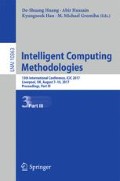Abstract
Using typical algorithms for training multilayer perceptron (MLP) creates some difficulties like slow convergence speed and local minima trapping in the solution space. Bio-inspired learning algorithms are famous for solving linear and nonlinear combinatorial problems. Artificial Bee Colony (ABC) algorithm is one among the famous bio-inspired algorithms. However, due to slow exploration process, it has been focused by researchers for further enhancement in optimization area. Therefore, this paper proposed a new hybrid swarm based learning algorithm called Global Crossover Artificial Bee Colony (GCABC) algorithm for training MLP for solving boolean classification problems. The simulation results of proposed GCABC algorithm compared with standard bio-inspired algorithms such as ABC, and Global Artificial Bee Colony (GABC) show that the proposed algorithm is achievable and efficient results in benchmark boolean function classification, with fast convergence speed.
Access this chapter
Tax calculation will be finalised at checkout
Purchases are for personal use only
References
Rosenblatt, F.: The perception: a probabilistic model for information storage and organization in the brain. In: James, A.A., Edward, R. (eds.) Neurocomputing: Foundations of Research, pp. 89–114. MIT Press, Cambridge (1988)
Du, K.L.: Clustering: a neural network approach. Neural Netw. 23(1), 89–107 (2010)
Karaboga, D.: An idea based on honey bee swarm for numerical optimization, pp. 1–10. Technical report TR06, Erciyes University, Engineering Faculty, Computer Engineering DepartmenTR06 (2005)
Suganthan, P.N.: Differential evolution algorithm: recent advances. In: Dediu, A.-H., Martín-Vide, C., Truthe, B. (eds.) TPNC 2012. LNCS, vol. 7505, pp. 30–46. Springer, Heidelberg (2012). doi:10.1007/978-3-642-33860-1_4
Kennedy, J., Eberhart, R.: Particle swarm optimization. In: Proceeding of IEEE International Conference on Neural Network 4, Australia, pp. 1942–1948 (1995)
Tairan, N.: Cooperative guided local search. Ph.D., University of Essex, UK, 573069 (2012)
Otair, M.A., Salameh, W.A.: Speeding up back-propagation neural networks. In: Proceeding of the 2005 Informing Science and IT Education Joint Conference, Flagstaff, Arizona, USA, pp. 167–173 (2005)
Nawi, N.M., Ransing, M.R., Ransing, R.S.: An improved learning algorithm based on the Broyden-Fletcher-Goldfarb-Shanno (BFGS) method for back propagation neural networks. In: Sixth International Conference on Intelligent Systems Design and Applications, ISDA 2006, vol. 1, pp. 152–157 (2006)
Alarifi, A.S.N., Alarifi, N.S.N., Al-Humidan, S.: Earthquakes magnitude predication using artificial neural network in northern Red Sea area. J. King Saud Univ. - Sci. 24(4), 301–313 (2012)
Cai, X., Gao, X.-Z., Xue, Y.: Improved bat algorithm with optimal forage strategy and random disturbance strategy. Int. J. Bio-Inspired Comput. 8(4), 205–214 (2016)
Karaboga, D., Akay, B., Ozturk, C.: Artificial bee colony (ABC) optimization algorithm for training feed-forward neural networks. In: Torra, V., Narukawa, Y., Yoshida, Y. (eds.) MDAI 2007. LNCS, vol. 4617, pp. 318–329. Springer, Heidelberg (2007). doi:10.1007/978-3-540-73729-2_30
Bullinaria, J.A., AlYahya, K.: Artificial bee colony training of neural networks. In: Terrazas, G., Otero, F.E.B., Masegosa, A.D. (eds.) Nature Inspired Cooperative Strategies for Optimization (NICSO 2013): Learning, Optimization and Interdisciplinary Applications, pp. 191–201. Springer, Cham (2014)
Olariu, S., Zomaya, A.Y.: Handbook of Bioinspired Algorithms and Applications. Chapman and Hall/CRC, Boca Raton (2005)
Guo, P., Cheng, W., Liang, J.: Global artificial bee colony search algorithm for numerical function optimization. In: 2011 Seventh International Conference on Natural Computation (ICNC), vol. 3, pp. 1280–1283 (2011)
Chambers, L.D.: Practical Handbook of Genetic Algorithms: New Frontiers, p. 448. CRC Press Inc., Boca Raton (1995)
Karaboga, D., Gorkemli, B., Ozturk, C., Karaboga, N.: A comprehensive survey: artificial bee colony (ABC) algorithm and applications. Artif. Intell. Rev. 42(1), 21–57 (2014)
Haupt, R.L., Haupt, S.E.: Introduction to optimization. In: Practical Genetic Algorithms, pp. 1–25. Wiley (2004)
Jalali Varnamkhasti, M., Lee, L.S., Abu Bakar, M.R., Leong, W.J.: A genetic algorithm with fuzzy crossover operator and probability. Adv. Oper. Res. 2012, 16 (2012). Article no. 956498
Zhang, T., Hu, T., Guo, X., Chen, Z., Zheng, Y.: Solving high dimensional bilevel multiobjective programming problem using a hybrid particle swarm optimization algorithm with crossover operator. Knowl.-Based Syst. 53, 13–19 (2013)
Ma, L., Hu, K., Zhu, Y., Chen, H.: A hybrid artificial bee colony optimizer by combining with life-cycle, Powell’s search and crossover. Appl. Math. Comput. 252, 133–154 (2015)
Zhu, G., Kwong, S.: Gbest-guided artificial bee colony algorithm for numerical function optimization. Appl. Math. Comput. 217(7), 3166–3173 (2010)
Toh, K.-A., Lu, J., Yau, W.-Y.: Global feedforward neural network learning for classification and regression. In: Figueiredo, M., Zerubia, J., Jain, Anil K. (eds.) EMMCVPR 2001. LNCS, vol. 2134, pp. 407–422. Springer, Heidelberg (2001). doi:10.1007/3-540-44745-8_27
Aijun, L., Yun-Hui, L., Si-Wei, L.: On the solution of the XOR problem using the decision tree-based neural network. In: 2003 International Conference on Machine Learning and Cybernetics, vol. 2, pp. 1048–1052 (2003)
Minsky, M., Papert, S.A.: Perceptrons: An Introduction to Computational Geometry. MIT Press, Cambridge (1969)
Author information
Authors and Affiliations
Corresponding author
Editor information
Editors and Affiliations
Rights and permissions
Copyright information
© 2017 Springer International Publishing AG
About this paper
Cite this paper
Shah, H., Tairan, N., Mashwani, W.K., Al-Sewari, A.A., Jan, M.A., Badshah, G. (2017). Hybrid Global Crossover Bees Algorithm for Solving Boolean Function Classification Task. In: Huang, DS., Hussain, A., Han, K., Gromiha, M. (eds) Intelligent Computing Methodologies. ICIC 2017. Lecture Notes in Computer Science(), vol 10363. Springer, Cham. https://doi.org/10.1007/978-3-319-63315-2_41
Download citation
DOI: https://doi.org/10.1007/978-3-319-63315-2_41
Published:
Publisher Name: Springer, Cham
Print ISBN: 978-3-319-63314-5
Online ISBN: 978-3-319-63315-2
eBook Packages: Computer ScienceComputer Science (R0)

